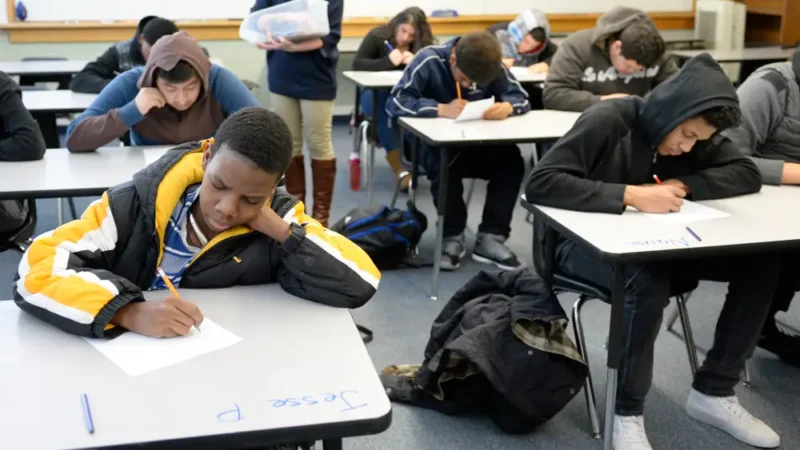The Rise of Virtual Reality in Education
Virtual Reality or VR is a rapidly growing technology and paving its way into various fields including education, medicine, entertainment, and more. In simple terms, VR is the use of computer technology to create a simulated environment, which instead of showing the computer screen to the user places him inside the 3D world and lets him interact and immerse in it. The rise of VR in education is a rising topic, making online classes more interactive and enhancing the learners’ experience in general.
Benefits of Virtual Reality in Education
While online classrooms are nothing new, there has always remained a need to make these digital classrooms more immersive and interactive. And that is where Virtual Reality plays its role. By improving the online learning and teaching experience of students and teachers respectively, VR offers various benefits in education including:
Increased Student Engagement
One of the key benefits of making online learning more realistic and virtually real is that it increases the engagement level of students. While students can easily get distracted when they are learning without direct supervision, in VR, they have to be fully immersed in the 3D classroom and can’t focus a lot on other stuff happening around them. Teachers can also take better control of their students and make the teaching method more interesting and engaging.
Improved Attention and Recall
Attention means the ability of a person to focus on a particular activity, and as mentioned earlier, when someone is immersed in a Virtual World wearing his headset, they naturally get more focused on the virtual world. Various studies have shown that VR enhances the attention and recall of learners and reduces their anxiety. Thus it is a powerful tool for students with attention problems or those who get nervous or anxious.
Access to Remote Places
Education is for everyone, but traditionally, many students living in remote areas didn’t have access to it or at least a high-quality education. With the rapid growth of the internet and the introduction of Virtual reality in education, even those living in areas far away from the best institutes can get the same quality of education as those living in urban areas. This helps eliminate illiteracy and offers equal opportunities for learning and growth.
Talking about access to online education, if you are interested in learning from the best teachers from around the world from the comfort of your home, and leveraging the power of VR, make sure your home internet connection is stable. And yes, students can spend fortunes on high-speed connectivity, so check out Windstream internet prices for some great deals on their reliable and lightning-fast service.
Real-World Examples of VR in Education
VR in education is not just a hypothetical thing but has been already used in real-world cases:
Science & Medicine Education
VR has been used to offer students a simulated laboratory experience in order to improve their understanding of experiments that involve dangerous or expensive materials. For example, companies like Labster have developed a virtual lab that allows students to perform experiments in chemistry, biology, and physics. Similarly, the University of Glasgow has developed a VR app that allows medical students to explore vital human organs, including the human heart, in 3D.
History Education
History might not be the favorite subject of most students due to the lack of visualization and the excess of theory students have to bear, but with VR, things are changing. VR can now transport students to different historical time periods and places, providing a firsthand experience that cannot be achieved through traditional teaching methods. The Anne Frank House in Amsterdam, for example, has created a VR experience that allows students to explore the secret annex where Anne and her family hid during the Nazi occupation of the Netherlands.
Special Education
VR has been used to provide special needs students with a more inclusive and immersive learning experience. For example, the Virtual Ability Island in Second Life provides a safe and accessible environment for students with disabilities to learn and socialize.’
Challenges and Limitations of VR in Education
Despite the many advantages it offers, VR in education certainly has its own set of challenges and limitations that need to be addressed, including:
Cost and Accessibility
While VR opens door to education for students living even in remote areas, there is a limitation when it comes to its access due to the higher cost of the infrastructure behind it. Governments and organizations need to work on this limitation in order to remove the barriers to education for students living in distant areas.
Technical Challenges
Being a relatively new technology, VR has some technical challenges that should be addressed. One of these challenges includes a lack of content; since the technology is a developing one, there is a lack of content related to various topics that are generally covered at schools and colleges.
Ethical Consideration
Last but not least, just as with any other sort of online education, there are ethical challenges when it comes to VR learning. These challenges include a lack of privacy and data security, the creation of bias and stereotypes among the students and teachers, additional and total dependency on VR and disinterest in the physical classroom, and a lack of equal accessibility.
Concluding Remarks
VR is a growing technology paving its way through various fields. The rise of VR in education offers numerous benefits, like improved engagement and attention, and access to remote areas. However, there are also some challenges related to cost, accessibility, ethics, and technicalities that need attention.
Overall, if governments and organizations can work towards dealing with these challenges, VR can prove to be a vital tool in improving the education system around the world.





